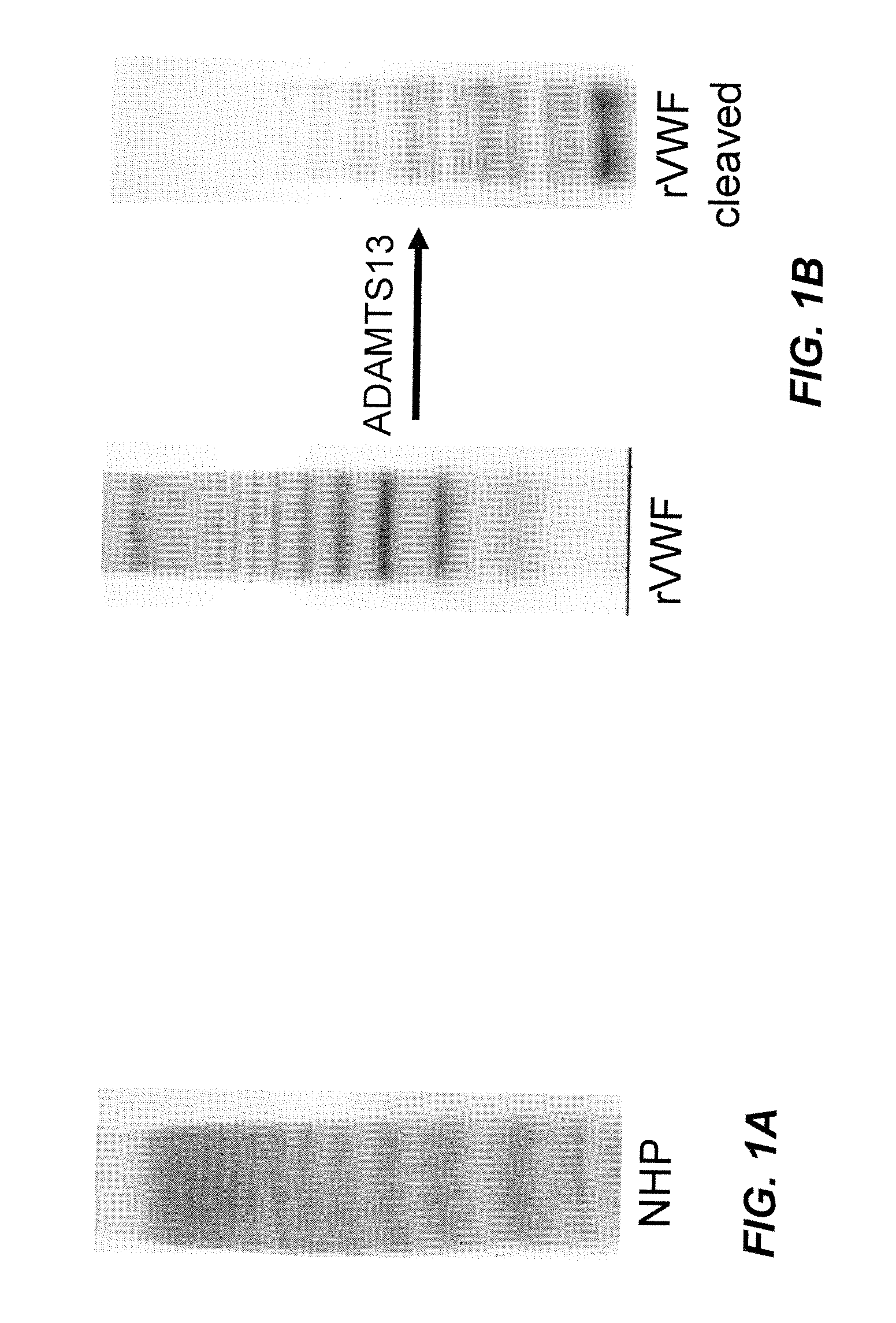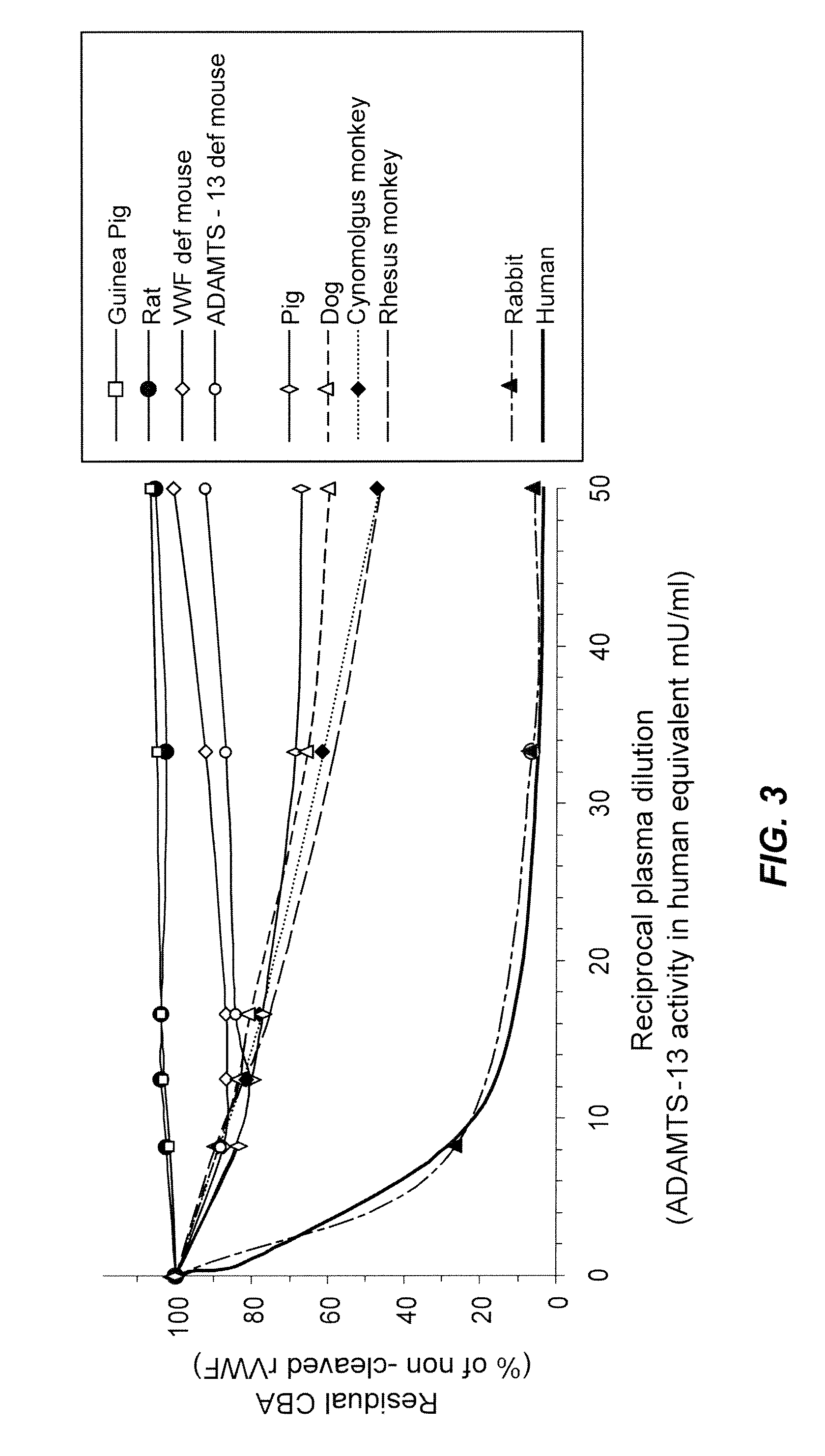Methods of measuring ADAMTS13-mediated in vivo cleavage of von Willebrand factor and uses thereof
a von willebrand factor and in vivo cleavage technology, which is applied in the field of methods of measuring cleaved von willebrand factor (vwf) fragments, can solve the problems of inability to test in vivo activity and thrombosis in microvasculature, and achieve enhanced chemiluminescence and increase sensitivity
- Summary
- Abstract
- Description
- Claims
- Application Information
AI Technical Summary
Benefits of technology
Problems solved by technology
Method used
Image
Examples
example 1
Susceptibility of Human Recombinant Von Willebrand Factor to ADAMTS13 Cleavage Varies Among Species
[0093]As set out herein above, VWF multimeric size and consequently VWF activity is regulated by ADAMTS13 activity in the blood. The aim of the study was to determine the susceptibility of human rVWF to cleavage by ADAMTS13 present in the plasma of different animal species. The ability of ADAMTS13 of different species to cleave human rVWF was tested in vitro as well as in vivo.
[0094]Determination of ADAMTS13 activity: Diluted plasma samples from various animals were treated with barium chloride to activate ADAMTS13. Human rVWF (1 U / mL) (obtained from CHO cells by fermentation and purification (Turecek et al., Blood 108: Abstract 1017, 2006; American Society of Hematology Annual Meeting Abstracts) was added and the mixture was incubated for 24 h under denaturing conditions (1.5 M urea). ADAMTS13 activity was then determined by a number of assays as described herein below.
[0095]Collagen ...
example 2
Quantification and Detection of ADAMTS13-Derived Cleavage Products in Plasma
[0115]The aim of the study was to develop an assay to determine if ADAMTS13-mediated cleavage of VWF (i.e., VWF fragments) could be detected in plasma samples of Type III VWD subjects after treatment with rVWF during a clinical study.
[0116]Normal human plasma, severe VWF-deficient human plasma, ADAMTS13-deficient human plasma, and Cynomolgus plasma samples, obtained before and after (1, 3, 9, 15, and 24 hours) rVWF injection (100 IU VWF:RCo / kg), were used. Completely and partially degraded rVWF treated with rADAMTS13 under denaturing conditions were used as controls.
[0117]Plasma samples were applied to SDS-PAGE under non-reducing conditions followed by Western blotting. The blots were stained with an HRP-labeled rabbit anti-human VWF polyclonal antibody (Dako), and developed with an enhanced chemiluminescence (ECL) plus technique.
[0118]Completely and partially ADAMTS13-degraded rVWF (1 Ag U / mL) were measured...
example 3
Detection of VWF Cleavage Fragments in Plasma from Subjects Before and after Treatment with RVWF
[0124]In the course of a clinical phase I trial, type III VWD subjects were treated with 7.5 IU VWF:RCo / kg body weight of rVWF. Blood samples were collected before the treatment and at various time points after the treatment up until 96 h and assayed for the presence of ADAMTS13-dependent VWF cleavage fragments.
[0125]The respective plasma samples were applied to SDS-PAGE under non-reducing conditions on 3-8% Tris-Acetate gels (500 nL per lane) followed by Western blotting using an HRP-labeled rabbit anti-human VWF polyclonal antibody (Dako) in combination with an ECL plus technique. VWD plasma (VWD-P, George King), normal human plasma (0.1 U / ml diluted in VWD plasma, NHP), rVWF (0.1 U / ml diluted in VWD plasma), and in vitro digested rVWF (1 nL diluted in VWD plasma, degradation control) served as controls. The 176 kDa dimer was not detectable in the pre-treatment sample, but was clearly d...
PUM
| Property | Measurement | Unit |
|---|---|---|
| temperature | aaaaa | aaaaa |
| temperature | aaaaa | aaaaa |
| temperature | aaaaa | aaaaa |
Abstract
Description
Claims
Application Information
 Login to View More
Login to View More - R&D
- Intellectual Property
- Life Sciences
- Materials
- Tech Scout
- Unparalleled Data Quality
- Higher Quality Content
- 60% Fewer Hallucinations
Browse by: Latest US Patents, China's latest patents, Technical Efficacy Thesaurus, Application Domain, Technology Topic, Popular Technical Reports.
© 2025 PatSnap. All rights reserved.Legal|Privacy policy|Modern Slavery Act Transparency Statement|Sitemap|About US| Contact US: help@patsnap.com



